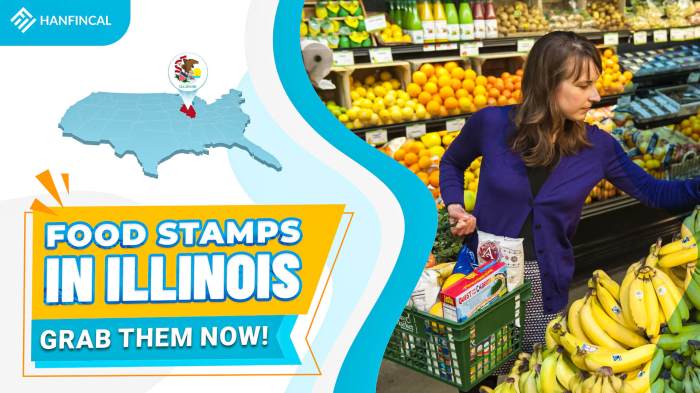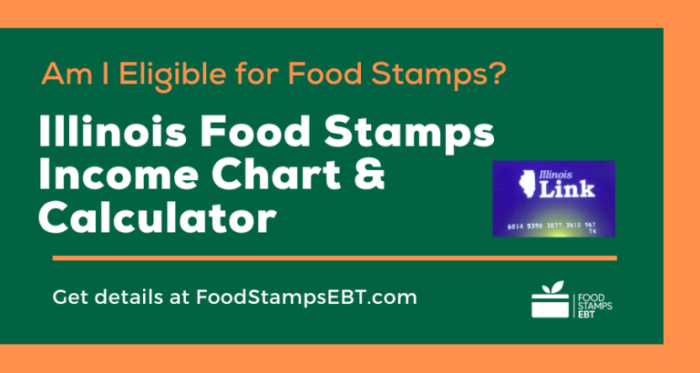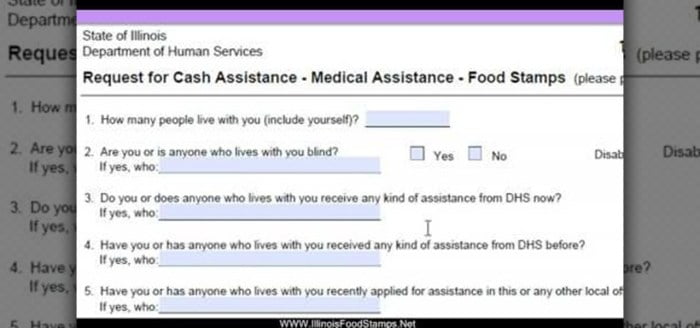In the face of economic hardship, accessing nutritious food can be a daunting challenge. Fortunately, the Supplemental Nutrition Assistance Program (SNAP), commonly known as food stamps, provides a lifeline for low-income individuals and families in Illinois. Understanding the eligibility criteria, application process, and benefits available through SNAP is crucial for those seeking food assistance.
This guide will delve into the intricacies of the SNAP program in Illinois, empowering you with the knowledge and resources to navigate the application process and secure the support you need. From eligibility requirements to benefit distribution, we will explore every aspect of SNAP to ensure you have the information you need to access this vital resource.
Eligibility Criteria

To qualify for SNAP benefits in Illinois, you must meet certain income and asset limits and belong to a qualifying category. The income limits are based on the federal poverty level (FPL), and the asset limits vary depending on your household size.
To be eligible for SNAP, your household’s gross income must be at or below 130% of the FPL. The FPL is a measure of poverty set by the federal government. For a household of four, the FPL is $2,576 per month in 2023. This means that a household of four with a gross income of $3,348 per month or less would be eligible for SNAP.
Asset Limits
In addition to income limits, there are also asset limits for SNAP eligibility. The asset limits vary depending on your household size. For a household of four, the asset limit is $2,500. This means that a household of four with assets worth more than $2,500 would not be eligible for SNAP.
Qualifying Categories
To be eligible for SNAP, you must also belong to one of the following qualifying categories:
- Households with children under the age of 18
- Households with elderly or disabled members
- Households with pregnant women
- Households with able-bodied adults without dependents who are working at least 20 hours per week
Documentation
To prove your eligibility for SNAP, you will need to provide documentation of your income, assets, and household size. This documentation can include pay stubs, bank statements, and a Social Security card.
Application Process

To apply for SNAP in Illinois, follow these steps:
- Visit the Illinois Department of Human Services (IDHS) website or your local DHS office to obtain an application form.
- Complete the application form carefully and accurately, providing all required information.
- Submit the completed application form to your local DHS office. You may also mail it or apply online.
Required Interviews and Documentation
You may be required to attend an interview with a DHS representative to verify your information. Bring the following documentation to your interview:
- Proof of identity (e.g., driver’s license, state ID card)
- Proof of income (e.g., pay stubs, bank statements)
- Proof of expenses (e.g., rent or mortgage receipts, utility bills)
- Proof of citizenship or legal residency (e.g., birth certificate, passport, permanent resident card)
Benefits and Allowances
The Supplemental Nutrition Assistance Program (SNAP) in Illinois provides various types of food assistance to eligible households. These benefits help individuals and families meet their basic nutritional needs.SNAP benefits are calculated based on household size, income, and expenses. The amount of benefits received varies depending on these factors.
Benefits are distributed electronically through an Electronic Benefits Transfer (EBT) card, which can be used to purchase eligible food items at authorized retail stores.In addition to food assistance, SNAP recipients may also be eligible for other benefits or services, such as:
Nutrition Education
SNAP recipients can access nutrition education programs that provide information on healthy eating habits, meal planning, and food safety. These programs help individuals make informed choices about the foods they purchase and consume.
Program Administration
The Illinois Department of Human Services (IDHS) is responsible for administering the Supplemental Nutrition Assistance Program (SNAP) in Illinois. IDHS oversees the program’s operations, including eligibility determinations, benefit issuance, and program compliance.
Local offices play a crucial role in SNAP administration. These offices provide direct assistance to applicants and recipients, including:
- Accepting and processing SNAP applications
- Determining eligibility and issuing benefits
- Providing information about SNAP and other assistance programs
- Resolving issues and grievances
Contacting Local Offices
To contact a local SNAP office, applicants and recipients can:
- Visit the IDHS website: https://www2.illinois.gov/hfs/Pages/default.aspx
- Call the SNAP hotline: 1-800-676-1335
- Visit the local office in person
Grievance Process
SNAP recipients have the right to file a grievance if they believe they have been treated unfairly or if they disagree with a decision made about their benefits. Grievances can be filed in writing, by phone, or in person at a local SNAP office.
IDHS will investigate the grievance and provide a written response within 45 days.
Additional Resources

For more information and support regarding SNAP in Illinois, you can refer to the following resources:
Relevant Websites and Organizations
- Illinois Department of Human Services: SNAP
- Get Food Stamps Now: Illinois
- Benefits.gov: Supplemental Nutrition Assistance Program (SNAP)
Local Food Banks and Community Resources
For immediate assistance with food, you can contact your local food bank or other community organizations:
- Greater Chicago Food Depository: (312) 641-5925
- Northern Illinois Food Bank: (800) 323-6040
- Central Illinois Foodbank: (309) 686-2530
Frequently Asked Questions and Answers
Here are some commonly asked questions and answers about SNAP in Illinois:
- Who is eligible for SNAP? Answer: Individuals and families with limited income and resources.
- How do I apply for SNAP? Answer: You can apply online, by mail, or in person at your local DHS office.
- What are the benefits of SNAP? Answer: SNAP provides monthly benefits to purchase food at authorized retailers.
Closure
With a comprehensive understanding of the SNAP program in Illinois, you are now equipped to make informed decisions about applying for and utilizing this valuable resource. Remember, accessing food assistance is not a sign of weakness but a testament to your resilience and determination to provide for yourself and your loved ones.
By leveraging the information provided in this guide, you can confidently navigate the SNAP application process and secure the nutritional support you deserve.
FAQ Section
What is the income limit to qualify for SNAP in Illinois?
The income limit for SNAP eligibility in Illinois varies depending on household size and composition. For a household of one, the gross monthly income limit is $1,834. For a household of two, the limit is $2,469. The limit increases by $635 for each additional household member.
What types of food can I purchase with SNAP benefits?
SNAP benefits can be used to purchase a wide variety of food items, including fruits, vegetables, meat, poultry, fish, dairy products, and bread. However, SNAP benefits cannot be used to purchase alcohol, tobacco products, or hot prepared foods.
How often are SNAP benefits distributed?
SNAP benefits are typically distributed on a monthly basis. The exact date of distribution varies depending on the county in which you reside.
What if I need additional assistance beyond SNAP benefits?
There are a number of additional resources available to low-income individuals and families in Illinois, including food banks, soup kitchens, and community pantries. Contact your local food bank or visit the Illinois Department of Human Services website for more information.